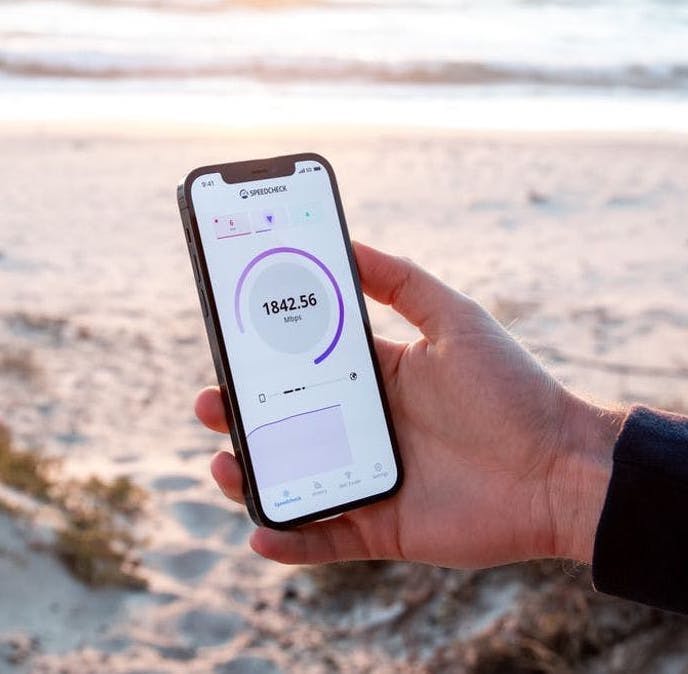Broadband connection types
The broadband connection types available where you live will affect the speeds you can get. Find out about what’s available in your area and what it means for your online experience.
What is a broadband connection?
Broadband is a high-speed internet connection. Most broadband services come into your home via fixed lines such as phone lines, cable or fibre-optic networks.
Broadband doesn’t always require a fixed-line; you can also get broadband via mobile phone networks, satellite internet and long-range wi-fi transmission.
The broadband connection you can get will depend on where you live, and what providers are operating in your area.
Types of broadband connection in Ireland
The main types of broadband connections available in Ireland are:
Fibre and Part Fibre broadband
The fastest type of broadband connection is Full Fibre (Fibre-to-the-Home) but Part Fibre (Fibre-to-the-Cabinet) can still offer very good connection speeds.
Full Fibre broadband
- Fibre broadband, also known as Fibre-to-the-home (FTTH) is delivered to your home using fibre-optic cables and delivers speeds of up to 2,000Mbps (2Gb)
- Full Fibre broadband is the fastest broadband and rolling out rapidly across Ireland. As it becomes more accessible, prices are dropping too
- Fibre-to-the-home (FTTH) is a good option if you need superfast speeds, but want broadband without a phone line
Part Fibre broadband
- Part Fibre also called Fibre-to-the-Cabinet (FTTC), delivers fibre to your nearest street cabinet and uses copper cables to bring the connection to your home
- The speed you’ll get from Part Fibre depends on your provider and your distance from the cabinet, but it’s fast enough for most households
- Part Fibre is faster than most other broadband connections and is a good option for affordable, speedy internet access
Is fibre broadband available in your area?
Fibre optic cables are being rapidly rolled out across Ireland, making it easier and cheaper to access high-speed internet.
However, in some areas, fibre broadband is still unavailable. If this is the case where you live, you’ll need to choose another type of broadband like mobile broadband, ADSL or satellite broadband.
Use our broadband checker to compare fibre deals where you live. You can get fibre broadband from:
ADSL broadband (standard)
Asymmetric Digital Subscriber Line (ADSL) broadband uses an existing home phone line to provide an internet connection of up to 24Mbps.
Although this type of connection is declining due to increased availability of fibre broadband, it will be some time before it is fully switched off.
Providers of ADSL broadband include Digiweb, eir, Pure Telecom, Sky, and Vodafone.
Cable broadband
Cable broadband connects your home via fibre-optic and coaxial cables.
Fibre-optic cables run from the exchange to a street cabinet in your area and then coaxial cables connect from the cabinet to your home.
Cable broadband is available from Virgin Media. The Virgin Media network reaches around one million households in Ireland.
Virgin media is currently rolling out full-fibre broadband to all their customers, which will eventually replace traditional cable connections.
Mobile broadband
Mobile broadband] is provided through your mobile phone signal. It’s useful for households without fibre or landline internet access and for people who need a fast connection on the move. Learn more about 5G mobile broadband in our guide.
Vodafone, Three, and eir all offer 5G mobile broadband deals.
Satellite broadband
Satellite broadband is set up in a household by installing a satellite dish and can provide speeds of up to 100Mbps-150Mbps, depending on who your provider is.
Wireless broadband
While most broadband is delivered through copper or fibre optic cables, wireless reaches your home via radio waves, like a mobile phone signal or a wide-ranging Wi-Fi hotspot.
If you take out a wireless broadband package, you’ll get sent a router that picks up on the signal from the provider’s masts in your area. This will transmit to your home and connect your devices to the internet.
How to check broadband availability
Your broadband options will depend on the providers operating in your area and if it has the infrastructure for full or part fibre.
If you’d like to learn about broadband availability where you live, our broadband comparison tool displays all of the broadband providers and plans in your area. Here’s how to check broadband availability near you.
Our complete guide to broadband covers everything you need to know about broadband in Ireland, including the broadband infrastructure, average broadband speeds and what you really need, plus lots more.
If you are ready to switch, our guide to switching broadband providers tells you more about choosing a new provider or switching broadband.
Enjoy superfast fibre broadband
Use our eircode checker to find your best deal and switch today
